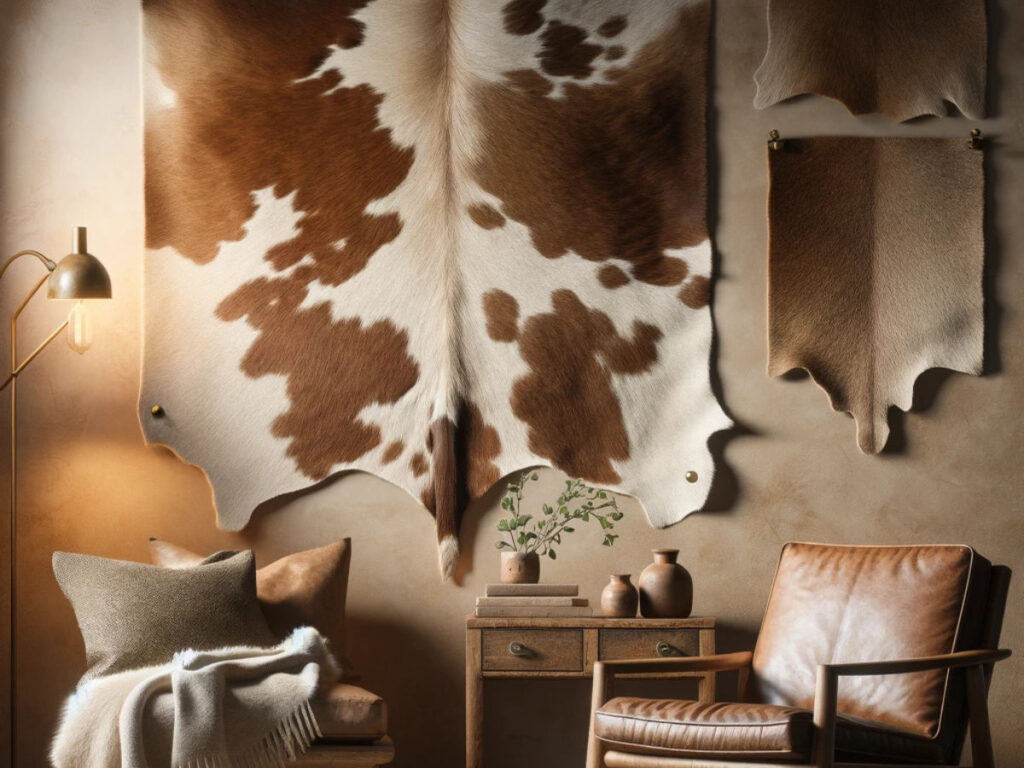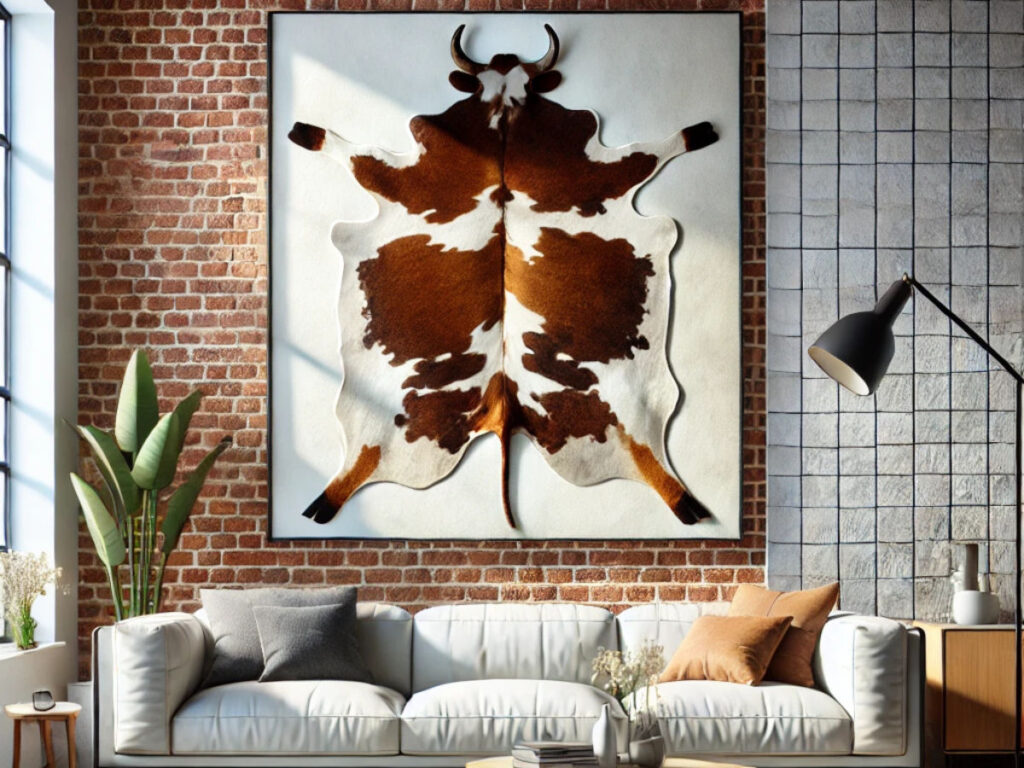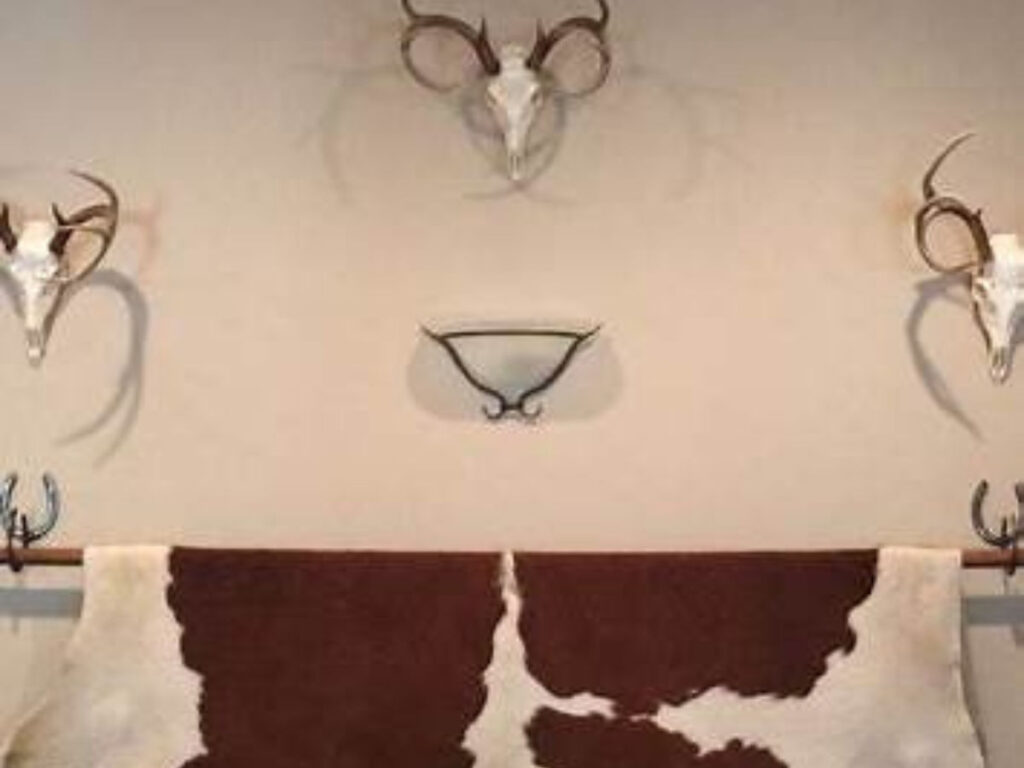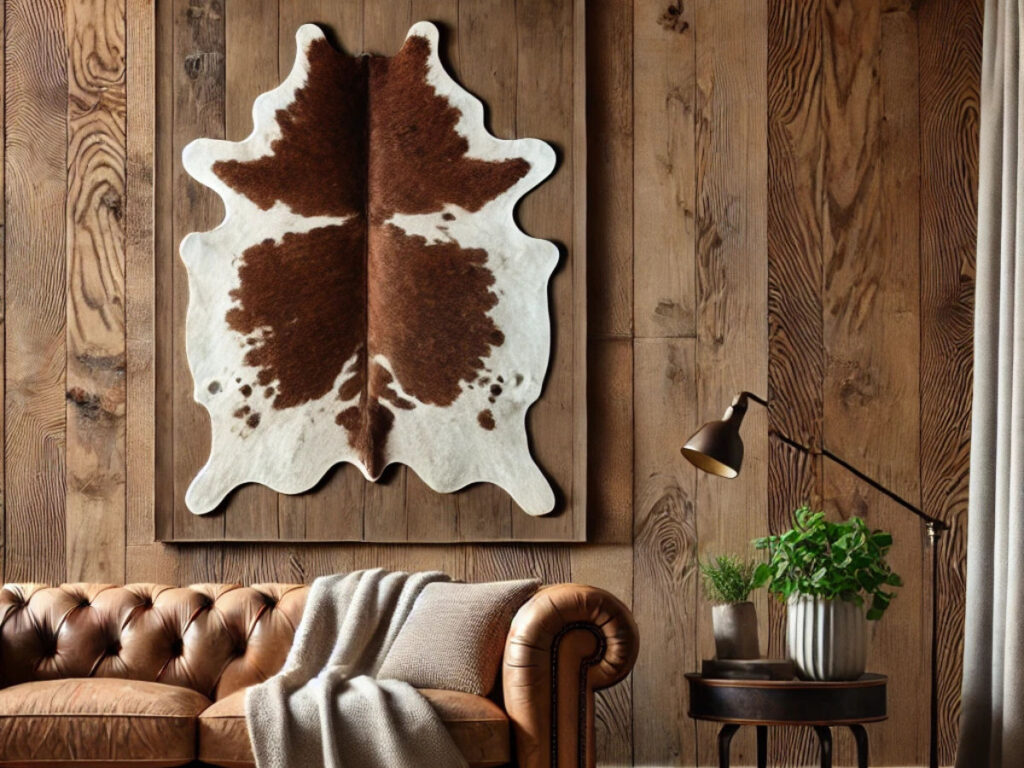Cowhide rugs are a statement of luxury and an excellent way to bring warmth, texture, and rustic charm to your home. So, if you want to hang a cowhide on your wall, you have come to the right place. Using this guide, we will help you ensure your cowhide is safe and nicely positioned.
Putting cowhide on the wall is one of the best ways to add a bit of personality and warmth to your home. With the proper selection of location, technique, and design, you can create a striking focal point that harmonizes with your space. If you maintain it properly, your cowhide will remain one of the finest pieces of decoration for many years.
Choose the Right Location for Your Cowhide

Before you begin the hanging process, the first step is finding the perfect spot for your cowhide. Choosing the right location will ensure the hide not only enhances your decor but also remains in good condition over time.
Factors to Consider:
- Room Lighting: Natural light will highlight the stunning colors of the cowhide. However, you should avoid direct sunlight because it can fade the colors eventually.
- Wall Size: The wall should be large enough to fit the hide but not overcrowded with other decoration pieces.
- Moisture Levels: Cowhides should not be placed in damp areas, such as bathrooms, as moisture can destroy the material.
Anecdote: When my friend decided to hang a cowhide in her living room, she initially placed it near a window. Over a few months, the vibrant colors faded slightly due to sunlight exposure. After moving it to a shaded wall, the hide retained its beauty.
Prepare Your Cowhide
Preparation of the cowhide will make it lie flat and hang well on your wall. Cowhides usually come folded or rolled into themselves, though this does leave creases.
Steps to Prepare:
- Unfold the Cowhide: Spread it out flat on a clean, dry surface. Allow it to settle for 24-48 hours to relax any creases.
- Flatten with Weights: For stubborn folds, place heavy books or other flat weights on the creased areas. Avoid using anything that could transfer moisture or stains.
- Clean the Cowhide: Use an easy brush or vacuum with a brush extra to remove any dust or debris.
Pro Tip: Escape using water or cleaning products, as these can loss the natural fibers of the cowhide.
Choose the Right Way to Hang

Hanging a cowhide on the wall will make your room look pretty as it adds texture and warmth to your decoration with its rustic or bohemian feel. Of course, choosing the right way to hang it is very important so your cowhide looks good and doesn’t ruin both the hide and your wall. The choice depends on whether you want it permanent or temporary, and the size of the hide compared to the kind of wall you have. Here are some public ways of hanging it with some tips on how to make it easy and positive.
1. Tacks or Nails
One of the simplest and oldest ways to hang a cowhide is by using small nails or upholstery tacks. This method is very good for thicker hides because it gives strong support without sagging.
- How to Do It: Fix the edges of the hide against the wall by using nails or tacks, working your way around from one corner, and tightening the hide so that it lies flat against the wall.
- Decorative Tip: In order to present a more elaborate look, opt for brass or decorative nails instead of regular nails, which suit the style in your room. Little details, like these can transform the view from plain and simple to stylish.
- Considerations: Be cautious if you’re concerned about wall damage, as this method will leave small holes.
2. Velcro Strips
For a damage-free, modern solution, Velcro strips are an excellent choice. They allow for a clean, minimalist look while ensuring the cowhide stays securely in place.
- How to Do It: Attach the adhesive side of the Velcro strips to the wall and the loop side to the back of the cowhide. Ensure they are properly aligned so the weight is evenly distributed.
- Pro Tip: Heavy-duty Velcro strips, made for large or heavy items, can be placed along the edges and in the center of the hide to prevent it from sagging or curling.
- Benefits: This technique is ideal for tenants or anyone who doesn’t want to poke holes into their walls. Moreover, it allows cowhide to be removed or relocated without any inconvenience.
3. Wooden Rod or Curtain Rod
For a very professional and museum-like look, the wooden or curtain rod can be used to hang the cowhide.
- To Do It: Sew a sleeve made of fabric to the cowhide’s back. Insert a rod through this sleeve. Hold it in place by using brackets attached to walls. This serves the purpose of keeping the hide flat and gives your decor an enhanced look at the same time.
- Design Benefit: The rod is straight-lined, so this method is excellent for large hides or modern rooms. You can coordinate the rod material and finish with other hardware in the room for a cohesive look.
- Considerations: This method takes a little more effort and planning, especially if you are sewing the fabric sleeve yourself.
4. Binder Clips and Hooks
Binder clips and hooks might be the best decorative solution for a person who likes updating their decor too often.
- How to Do It: Attach binder clips along the edges of the cowhide and hang them on wall hooks. This method is best suited for a hide that one is not sure they want to be permanently located in the room.
- Flexibility: Great for temporary arrangements or to just test out how things look in a room. It’s not difficult to move decorations around or to change them entirely.
- Aesthetics Tip: Select hooks and clips that best suit the type of room it is in. Example: Black, smooth clips can be fantastic for modern-looking rooms, but wooden hooks go really well for farmhouse or vintage settings.
Prep the Wall and Position the Hide

To ensure your cowhide hangs securely, it’s essential to prepare the wall beforehand.
Steps to Prep the Wall:
- Clean the Wall: Use a damp cloth to remove dust and grease. A clean surface ensures adhesive methods like Velcro will stick properly.
- Mark the Position: Use a pencil or masking tape to mark the desired position of the hide. This prevents uneven placement.
- Check for Studs: If you’re using nails or a rod, locate wall studs for added support, especially for larger cowhides.
Hang the Cowhide
Hanging a cowhide on the wall is a unique way to introduce a rustic and natural element to your interior design. To begin, hanging the cowhide involves choosing a secure and appropriate method. Velcro strips are another favorite among many because they are easy to use and take off without hurting anything.
If someone wants a more permanent choice, decorative brass tacks or nails can offer a nice and strong solution. Another option is to use a wooden rod, spreading the weight of the hide evenly, and keeping it smooth and secure. Once you’ve chosen your method, ensure the cowhide is laid flat and aligned properly before attaching it to the wall. This ensures a neat, polished appearance that elevates the space.
Adjust and Style
Adjusting and styling the cowhide after it’s hung is essential for achieving the desired aesthetic. Take a step back to evaluate its placement, making sure it hangs straight without any sagging or wrinkles. The hide’s natural patterns and colors should complement the existing decor in the room. Pairing it with rustic furnishings, such as a wooden coffee table or leather chairs, can enhance the cohesive look.
Adding subtle decorative accents like metallic frames or potted plants nearby can further highlight the cowhide’s texture and charm.
Some Top Tips for Hanging a Cowhide Skin towards the Wall

Some top tips for hanging a cowhide skin towards the wall include selecting a location that is free from direct sunlight to prevent fading over time. It’s also wise to avoid high-traffic areas where accidental bumps could cause damage. If you’re uncertain about the perfect placement, try temporarily securing the cowhide with binder clips to test different positions before making a permanent decision.
Ensure the hide is clean and dust-free before installation for a flawless presentation. Regularly check that it remains securely attached to the wall to maintain its aesthetic appeal.
Final touches and considerations
Final touches and considerations are important to make the cowhide a special part of your room. Smooth out any rough edges or uneven spots to keep the hide looking elegant. Regular maintenance, such as thorough vacuuming or brushing, will keep it looking great. Be mindful of the humidity in the room because excessive moisture can degrade the strength of the cowhide over time. Any sign of wear or looseness should be fixed immediately to extend its life and look as beautiful as the day it was hung.
Frequently Asked Questions
How do I clean a cowhide once it’s on the wall? Gently remove dust with a soft brush or a vacuum cleaner using a brush attachment. Avoid using water or harsh chemicals.
Can cowhides be hung in kitchens or bathrooms? It’s not recommended due to the high humidity and potential for spills, which can damage the hide.
What’s the best way to test placement before hanging permanently? Use binder clips to temporarily secure the hide to the wall. This allows you to experiment with different positions and alignments.
Is it possible to move the cowhide without damaging the wall? Yes, especially if you use Velcro strips or other non-permanent methods. These options allow for easy repositioning without leaving marks.
How do I prevent the edges from curling over time? Regularly smooth the edges and ensure the hide is properly secured. Using a wooden rod or additional Velcro can help keep it flat.
You don’t just write — you craft experiences. And this one left me quietly moved and deeply grateful.